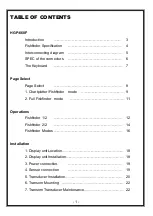
69
FishTrack
The FishTrack feature shows the depth of a fish symbol when it
appears on the display. This lets you accurately gauge the depth of
targets. This feature is available only when the Fish I.D. feature is on.
The default setting for FishTrack is off.
To turn on FishTrack:
(
Note:
These instructions will turn on FishTrack
and
Fish I.D. at the
same time.)
1. From the Sonar Page, press
MENU
|
↓
to
S
ONAR
F
EATURES
|
ENT.
2. Press
→
↓
to
F
ISH
D
EPTHS
|
ENT
|
EXIT
|
EXIT
.
To turn off FishTrack, repeat the instructions in step 1. Turning off
FishTrack in this manner will not turn off Fish I.D. symbols.
Sonar Features menu with Fish I.D. Depths selected (left). When the
check box to the left is unchecked, the feature is off. Sonar Page
showing Fish I.D. symbols and FishTrack depths turned on (right).
Frequency (Change Transducer Frequency)
(Dual-Frequency Transducers only)
A dual-frequency transducer operates with both 200 kHz and 50 kHz.
The 200 kHz frequency has a 12
°
cone angle and the 50 kHz frequency
has a 35
°
cone angle.
The default frequency is 200 kHz, which is best for use in shallow water
(about 300 feet or less). This frequency is the best choice for about 80
percent of the fresh and salt water sport fishing applications. When you
get into very deep salt water, 300 to 500 feet or deeper, the 50 kHz
frequency is the best choice.
The 200 kHz transducer will give you better detail and definition, but
less depth penetration. The 50 kHz transducer will give you greater
depth penetration, but a little less detail and less definition. (Remember,
all sonar units typically read deeper in fresh water than in salt water.)
Symbols with
FishTrack depths
Summary of Contents for LCX-20C
Page 98: ...90 Notes...
Page 102: ...94 Notes...
Page 186: ...178 Notes...
Page 192: ...186 Notes...
Page 193: ...187 Notes...
Page 194: ...188 Notes...































